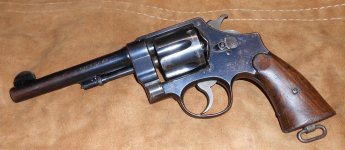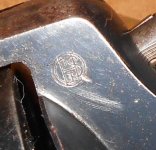I found this early M1917 today at a local pawn shop....Fair condition but OK for it's age I guess.
Serial # 9939.
GHS stamp....Concave grips....Circular mill marks on the hammer....All matching.....I could even still make-out the penciled serial on the right grip.
No rebuild evidence.
I gave $350.00 for it.
Serial # 9939.
GHS stamp....Concave grips....Circular mill marks on the hammer....All matching.....I could even still make-out the penciled serial on the right grip.
No rebuild evidence.
I gave $350.00 for it.



